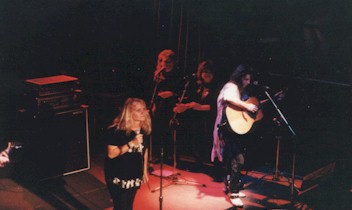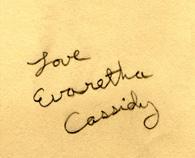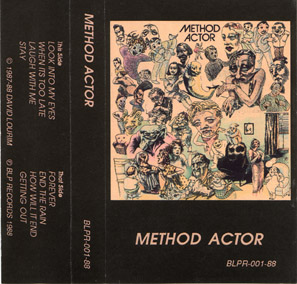 The first album on which Eva Cassidy sang, METHOD ACTOR, originally had a limited release in LP and cassette format in 1988. Eva sang lead vocals and backup harmonies on eight original songs by David Christopher. She also contributed the charmingly idiosyncratic artwork for the album cover.
The first album on which Eva Cassidy sang, METHOD ACTOR, originally had a limited release in LP and cassette format in 1988. Eva sang lead vocals and backup harmonies on eight original songs by David Christopher. She also contributed the charmingly idiosyncratic artwork for the album cover.
All the vocal parts on the album are Eva’s, but the album was intended as a showcase for David’s songs and for the band as a whole, not as a solo album for Eva Cassidy. No photographs were printed on the album cover. Eva’s name is listed on the back of the album cover along with those of David Christopher (then known as David Lourim), bassist Ken Fiester, drummer Jim Campbell, and additional musicians Ned Judy (“Grand Piano and Synthesizers”), Bob Fiester (guitar), Jeff Lourim (synthesizers), Tom Crawford (sax), Mark Izzi (sax), and Tom Prasada-Rao (violin). The album was produced by David Christopher and the recording engineer was Chris Biondo. The “A” and “B” sides of the album, each with four songs, were whimsically called “This Side” and “That Side”! Also on the back side of the album cover is a dedication of the album to Brian Ball, and “Thanks To: Chris & Christine, Biondo, Ron Kent, Bob Fiester, Mark, Vinh Phan, David Frey, The Kents, Wendy Wichroski, & our families.”

The recording of the METHOD ACTOR album is discussed in detail in my interview with David Christopher and briefly in the Washington Post Magazine article written by Jefferson Morley. It has often been said that the pop-style music of METHOD ACTOR was not to Eva’s taste, but her friend Ruth Murphy remembers, “She was happy to have the opportunity to sing on an album.”
Eva proudly gave copies of the LP to her friends and relatives. But Ruth says, “What she was most excited about was her artwork on the album cover. When she first got a copy of the album she was waving it around, saying ‘Ruth, Ruth, look!’ She wanted me to comment about the pictures, not the singing.”

Making the album METHOD ACTOR was a turning point in Eva’s career as a singer. It was her first experience working in a real recording studio, though she had spent time experimenting with her friend Ned Judy’s “four-track” equipment. Black Pond Studios in Rockville was owned and run by a local musician named Chris Biondo, who was to become an important person in Eva’s life and career. Thus METHOD ACTOR led directly to the formation of the Eva Cassidy Band and the albums THE OTHER SIDE (with Chuck Brown), LIVE AT BLUES ALLEY, and almost all the songs on the posthumously-released albums.
 The METHOD ACTOR album was reviewed in the “Weekend” section of the Washington Post in September, 1988, along with several other locally-produced albums (see left). Pop music critic Joe Brown wrote, ‘METHOD ACTOR: Eva Cassidy is the noteworthy singer fronting this Gaithersburg quartet — she also did the strikingly eccentric etchings on the cover. Cassidy’s got a cool, otherworldly tone on songs like “Look Into My Eyes,” and when she multitracks her vocals she sounds like Heart’s Ann Wilson minus the histrionics; there’s a faintly metallic Grace Slick tinge to the neopsychedelic “How Will It End.” The band, led by David Lourim, who writes the songs, plays the fluid guitar lines and adds the washes of keyboards, creates sometimes dreamy (“When It’s Too Late”), sometimes playful (“Laugh With Me”), backdrops. Another find.’
The METHOD ACTOR album was reviewed in the “Weekend” section of the Washington Post in September, 1988, along with several other locally-produced albums (see left). Pop music critic Joe Brown wrote, ‘METHOD ACTOR: Eva Cassidy is the noteworthy singer fronting this Gaithersburg quartet — she also did the strikingly eccentric etchings on the cover. Cassidy’s got a cool, otherworldly tone on songs like “Look Into My Eyes,” and when she multitracks her vocals she sounds like Heart’s Ann Wilson minus the histrionics; there’s a faintly metallic Grace Slick tinge to the neopsychedelic “How Will It End.” The band, led by David Lourim, who writes the songs, plays the fluid guitar lines and adds the washes of keyboards, creates sometimes dreamy (“When It’s Too Late”), sometimes playful (“Laugh With Me”), backdrops. Another find.’
The “Method Actor” band performed at several local venues, with additional musicians added to the core group that had recorded the album. MaryBeth Bernui and her then-husband Tony were friends of David Christopher who joined “Method Actor” to sing back-up vocals behind Eva’s lead vocals at their live performances. MaryBeth Bernui, now a government lawyer in Nashville and part of musical duo The Twangtown Paramours, expresses enormous admiration for Eva’s vocal harmonies. “When we first starting learning the background vocals for some of the ‘Method Actor’ songs, we couldn’t get over how intricate and complicated they were. Most of the time she composed three- and four-part harmonies to go with the lead vocal.
| “The first time we rehearsed, Eva was so shy she sang in a broom closet under the stairs.” |
“We were having trouble figuring them out by just listening to the tape ourselves, so Eva would sometimes have to listen to the tape and pick out the parts for us that we weren’t quite getting. I remember sitting on the floor with Eva and my husband Tony at rehearsal, and listening while she sang the background vocal parts along with the studio tape on some of the songs. It took Tony and I quite a bit of rehearsing — both running the parts with Eva and practicing at home, in the car, and pretty much everywhere we could practice, to reproduce live the incredible harmonies that Eva created in the studio. I think her talent to create such beautiful vocalizations, with her backgrounds so intricately incorporated into her lead vocals, was simply incredible and is probably underappreciated by most folks who listen to her work. She was not only amazingly talented as a lead vocalist but was a great composer, arranger and producer.”


“The first time we played live at a showcase in D.C., she made us stand up front next to her, because she was so afraid of singing before an audience. We couldn’t believe it — because she was and is still the best singer we have ever heard. I always thought I was a pretty good singer until she opened her mouth and I was immediately humbled. She sang all the way up from her toes and listening to her sing still makes me cry. We all called Eva ‘Eva-retha’ because she sang better than Aretha Franklin!”
In the fall of 2001, an original LP of METHOD ACTOR sold for $510 on the popular Internet auction site eBay. Shortly thereafter, another copy sold for $500. The high price that these LPs commanded is good news in a way, because it will probably encourage a few other people to sell their copies of the album — perhaps we can expect a few more to turn up. I suspect that some friends of the original band members have a spare copy or two tucked away somewhere, for example. Since Eva did the artwork for the cover, in her inimitable style, it’s really a “two-fer” for Eva Cassidy fans.
 Some facts about the original METHOD ACTOR album : It is a genuine rarity. Only 1,000 were manufactured, and of those, many had warped during shipping and were defective. The album never had proper distribution; it would have been sold at the group’s occasional live engagements (mostly cassettes), given out as demos to people in the music business and at radio stations, bestowed upon family and friends of the musicians, and possibly sold on consignment at a few DC-area record stores. The album was issued both as a vinyl LP and as a cassette. The LP cover features Eva’s own artwork, definitely “suitable for framing,” and the cassette cover (see right) is a miniature version of the LP cover, minus some of the personnel credits.
Some facts about the original METHOD ACTOR album : It is a genuine rarity. Only 1,000 were manufactured, and of those, many had warped during shipping and were defective. The album never had proper distribution; it would have been sold at the group’s occasional live engagements (mostly cassettes), given out as demos to people in the music business and at radio stations, bestowed upon family and friends of the musicians, and possibly sold on consignment at a few DC-area record stores. The album was issued both as a vinyl LP and as a cassette. The LP cover features Eva’s own artwork, definitely “suitable for framing,” and the cassette cover (see right) is a miniature version of the LP cover, minus some of the personnel credits.
Is the original LP album worth five hundred dollars? Is the cassette worth the $130 that it recently fetched on eBay? The marketplace will have to decide. I definitely wouldn’t part with my own copy for that price, or even a lot more.
In 2002, METHOD ACTOR was re-released on CD, with two additional songs. It was originally marketed as if it were a new Eva Cassidy album, with Eva’s name in prominent letters above the cover’s artwork. Eva’s parents and Blix Street Records objected to this, and eventually the cover was changed to look like a miniature version of the original LP.
Even now that the music has been re-issued on CD, the original METHOD ACTOR LP and especially its cover are still highly collectible.
Copyright 2002, 2003 – Laura C. Bligh. Thank you to David Christopher and Vinh Phan for the use of the snapshots on this page, and to MaryBeth Zamer and Ruth Murphy for their insights. Please do not copy the images on this website, which are shown with the permission of the copyright holders.
